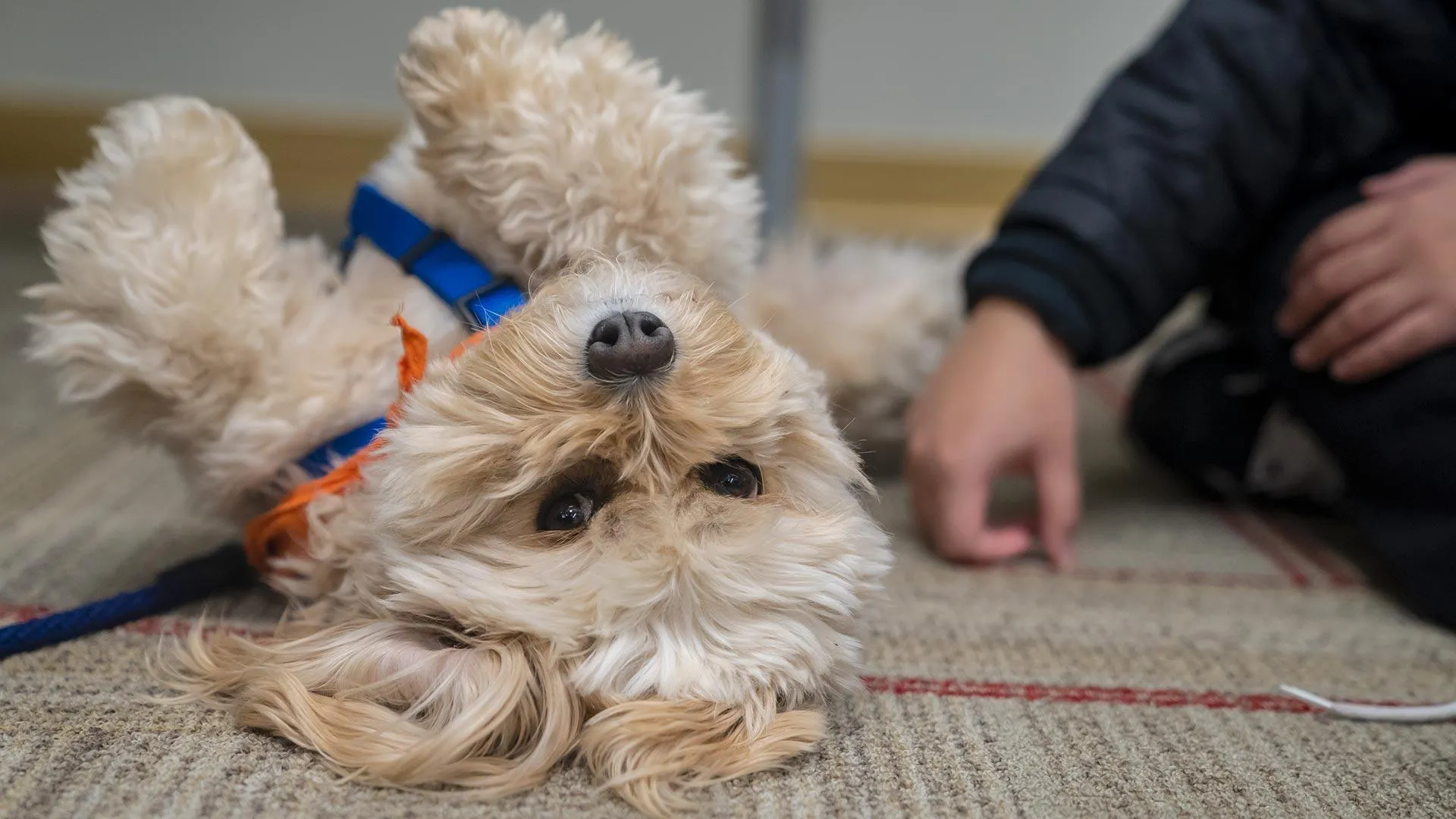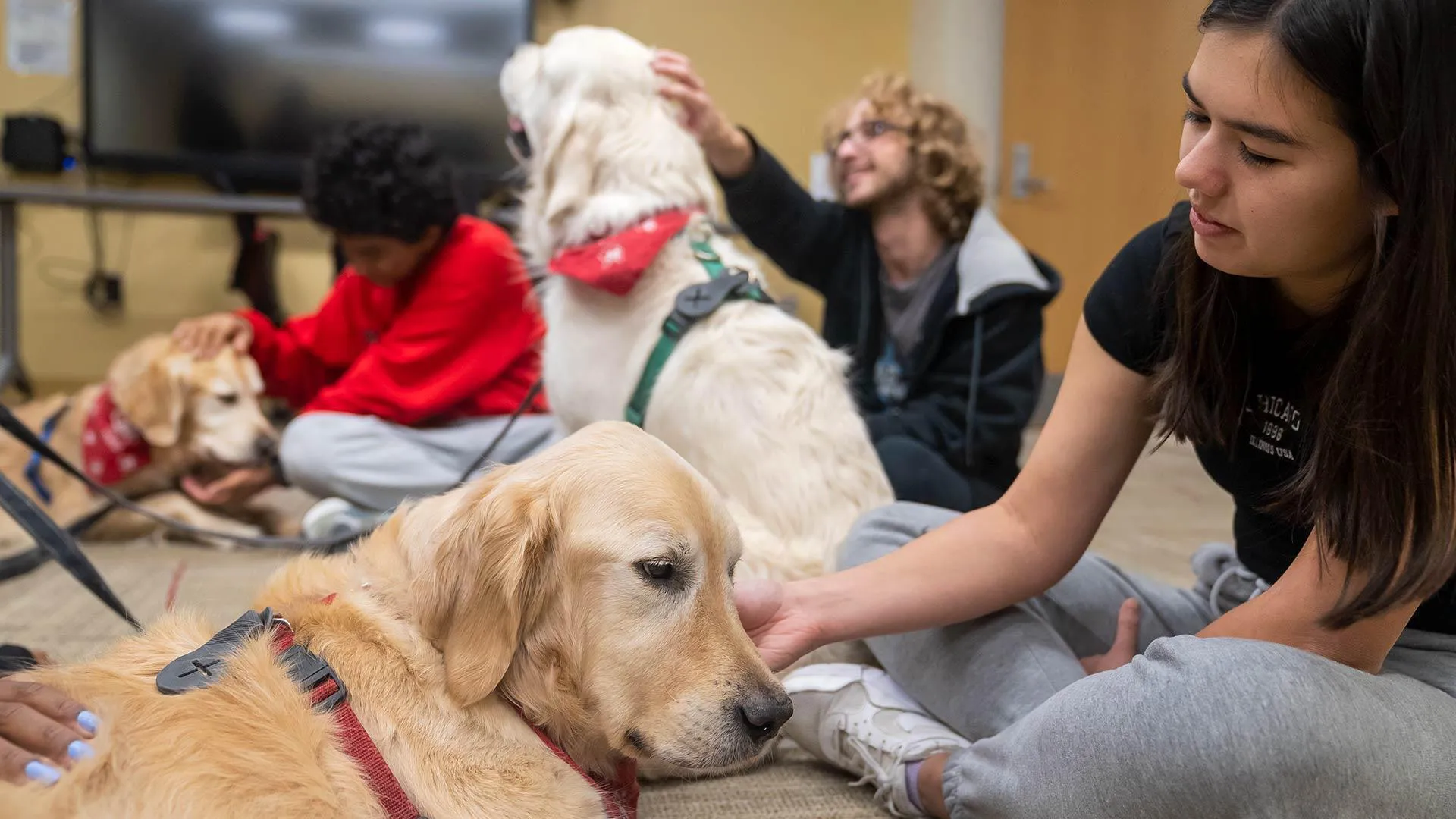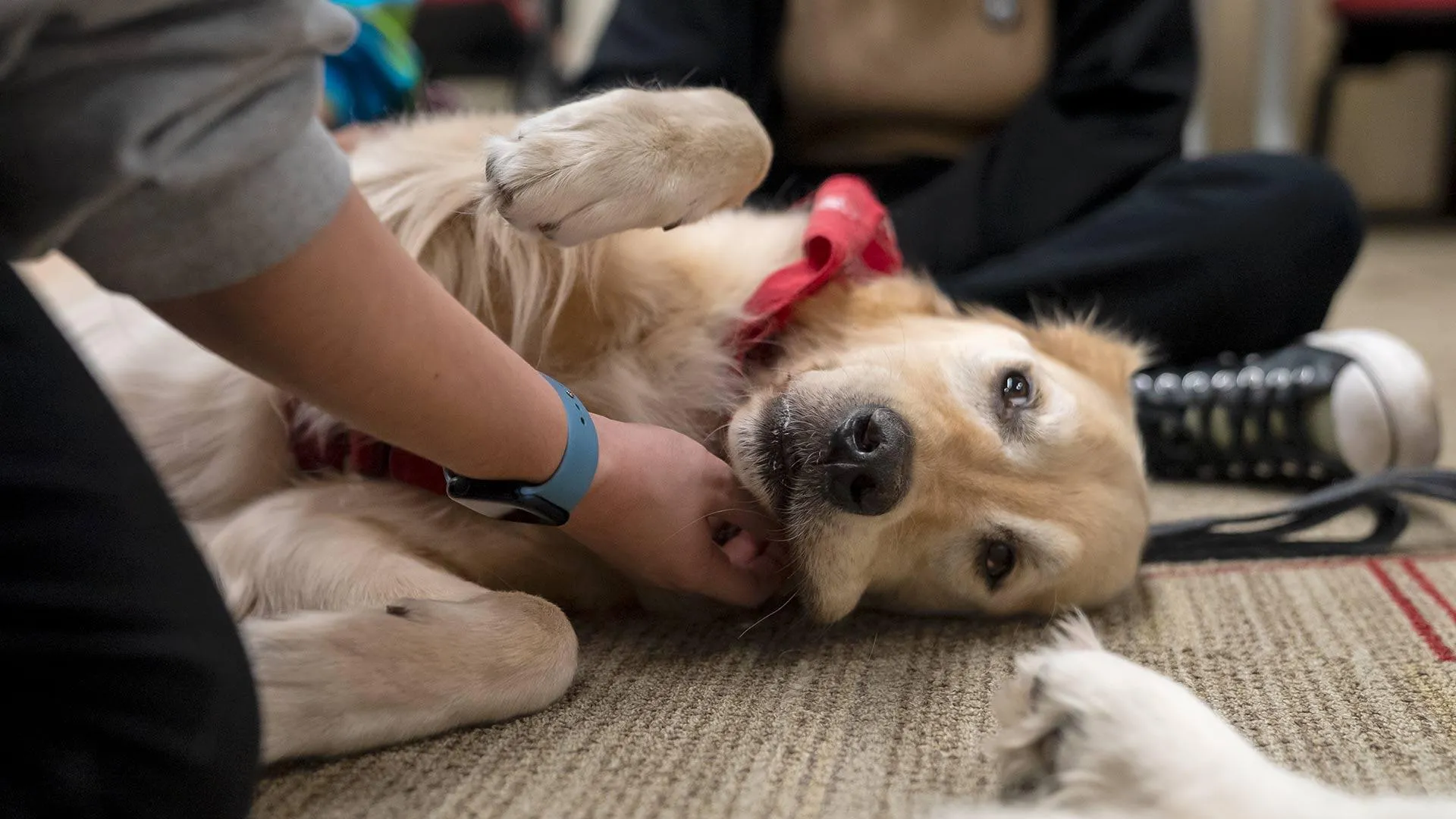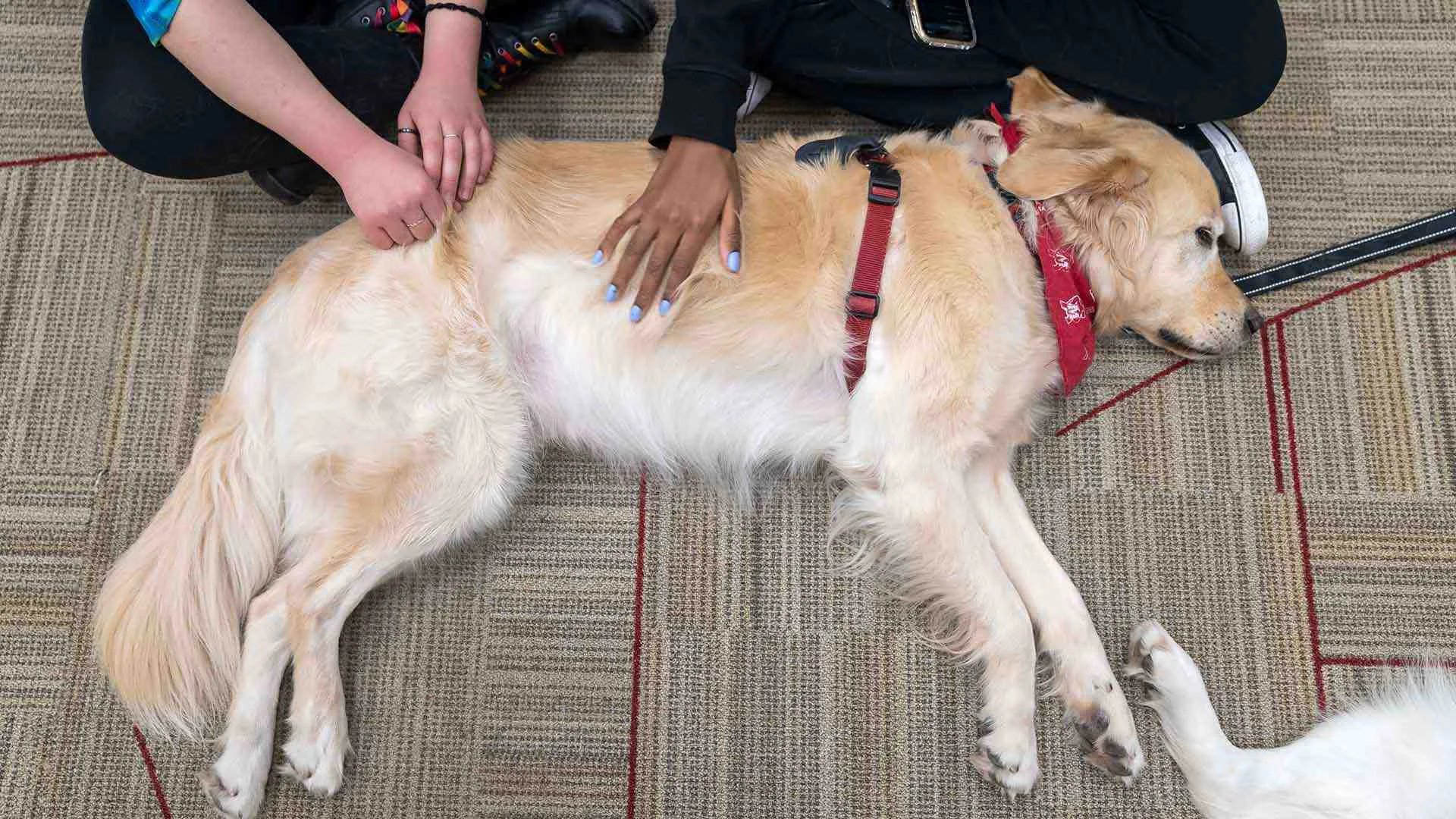- December 07, 2022
- By Karen Shih ’09
Amid the hustle and bustle of Stamp Student Union, where eager students sell brownies for campus clubs, prospective Terps follow tour guides like ducklings and chatter fills the food court, a furry oasis awaits.
Just inside the Student Involvement Suite, dogs big and small sprawl out on the carpeted floor, proffering bellies for rubs and chins for scratches. Terps settle down next to a curly-haired Cavachon (that’s a Cavalier King Charles spaniel and a bichon frisé mix) or a friendly Lab, getting lost in their big eyes and relaxing as they pet outstretched paws—and that’s the whole point.
The dogs are part of the Wags for Wellness program, offered three times a month by the University Health Center (UHC) throughout the school year to help improve student mental health and reduce stress. The final two sessions of the semester are at 11 a.m. tomorrow at the health center and 1 p.m. Dec. 16 in McKeldin Library.
“Research tells us that just 10 minutes with a dog lowers cortisol levels,” reducing stress, said Sarah Wilson, the UHC’s wellness strategy coordinator.
Wilson and colleague Olivia Mays, who run the Wags program, and volunteer Cathy Loyd, who regularly brings golden retrievers Max, Finley and Sawyer to campus, explain why it’s more than a finals week-only event, how they create a safe and welcoming environment for both students and dogs, and the importance of having volunteers who return year after year.
Mays: Wags for Wellness features well-trained and highly skilled volunteer pups, along with their human handlers. We work with an organization called People Animals Love (PAL) to run this program. Our visits are catered to students, but some faculty and staff attend, and sometimes we’ll see parents come through during orientation or Family Weekend.
Wilson: I love it when there’s a tour on campus and they pop by a Wags session. I’m like, “Yeah! We got them.”
We started this program in 2016. A lot of schools do this type of programming, but more often than not they’re centered around midterms or finals. It was important to me and the health center that we offer these programs on a more regular basis. Stress can happen at any point.
Mays: We partner with Stamp and McKeldin to offer Wags three times a month, and we usually have four or five dogs. We started registrations after COVID for contact tracing, but now we find that students really like it for accountability. It also helps us track how many students are coming and control the amount of people in each space. We offer 15-minute slots, which we find to be the sweet spot, but students can sign up for more than one.
Wilson: We usually get around 60 to 100 people per two-hour session, and up to 200 on a busy day. When we do one-off programs, called “Pup-ups,” during big events like Mental Health Awareness Week or Terps After Dark, we can easily see 400 students in two hours.
Students ask us all the time, “Who are these dogs? Are they up for adoption?” The answer is: They’re someone’s personal pet who has been deemed a very good fit for an animal-assisted activity.
PAL evaluates a dog’s behavior and how their handler works with them. Then, they send these volunteers throughout the DMV, working with young children, older adults and everyone in between.
Mays: One of the things that makes this program so special is that we have the same volunteers and dogs return, so that attracts students to come back.
Loyd: We’ve been volunteering with PAL since 2009 and at UMD since they had Stress Week and things like that, before Wags. We’re very familiar with the campus—my daughter graduated in 2013. When she went away to college, she missed her pets so much. When I heard UMD was doing this, I knew this was something I wanted to do. Students get homesick and lonely, and some of them want to have pets but can’t.
Wilson: We tend to see a lot of golden retrievers and Labradors, which is very common in the field of animal-assisted activities. But we quickly received feedback from students that they wanted smaller dogs too. We worked very hard to expand our offerings, and now, we have a large variety of dogs visiting.
Animal welfare is of the highest priority. Every single event we do is approved by the campus veterinarian to make sure it’s safe. We consider infection control, the presence of food and water, and breaks for the dogs. We work closely with the volunteer handlers to make sure the dogs are having a good time. You can see that from their behaviors: They’ll put their bellies up, or their heads in a student’s lap.
Loyd: My dogs absolutely love UMD because when we go visit hospitals or schools, not everyone likes dogs or wants to be around dogs. But here, it’s a totally different feeling. Everyone who walks into these rooms loves them. I always tell people it’s a win-win-win. The dogs love getting all the attention and the pets. I love helping other people and seeing the smiles on the students’ faces. And the students tell me how much it helps them with stress relief and loneliness.
Wilson: We’ve seen students finish a final exam and run to a Wags session to say goodbye to a dog before they graduate. They’ve created collage books and brought gifts for the dogs. These are really special and important relationships in their career at Maryland.
This is part of a monthly series that looks behind the scenes at “what it takes” to keep the University of Maryland humming and create a vibrant campus experience. Got an idea for a future installment? Email kshih@umd.edu.

Cooper, a Cavachon (Cavalier King Charles spaniel and bichon frisé mix), is one of the smaller dogs at Wags for Wellness sessions. “He likes his work,” said volunteer Emily Mazzella, who has been bringing him to UMD for about a year. “He’s super social—he used to sit in front of the window and look out, so when I saw a local library had a session where kids would come read to dogs, I figured he would be perfect for that. That’s how I found PAL.”

“They’re used to working as a team,” volunteer Cathy Loyd said of her golden retriever trio. “They each settle into their own place and are each surrounded by students.” From left, Kai Ghebrehiwet ’26 pets Sawyer; Michael Koretsky ’24 pets Finley and Natalie Weger ’26 pets Max.

Golden retriever Max gets chin scratches.

Max, the longest-serving dog in the Wags for Wellness program, relaxes next to students.
